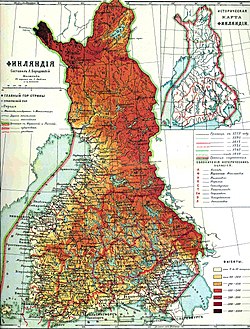
Back مملكة فنلندا (1918) Arabic Finlandiya krallığı Azerbaijani Каралеўства Фінляндыя Byelorussian Каралеўства Фінляндыя (1918) BE-X-OLD Regne de Finlàndia (1918) Catalan Finské království Czech Kongeriget Finland Danish Königreich Finnland German Reĝlanda projekto de Finnlando (1918) Esperanto Reino de Finlandia (1918) Spanish
This article needs additional citations for verification. (January 2011) |
You can help expand this article with text translated from the corresponding article in Finnish. (November 2011) Click [show] for important translation instructions.
|
Kingdom of Finland | |||||||||||
|---|---|---|---|---|---|---|---|---|---|---|---|
| 1918–1919 | |||||||||||
| Anthem: Maamme (Finnish) Vårt land (Swedish) (English: "Our Land") | |||||||||||
 Map of the Grand Duchy of Finland, which had the same borders as independent Finland from 1917 until 1920 | |||||||||||
| Capital | Helsinki | ||||||||||
| Common languages | |||||||||||
| Religion | Evangelical Lutheranism Finnish Orthodoxy | ||||||||||
| Demonym(s) | Finnish, Finn | ||||||||||
| Government | Constitutional monarchy under a regency | ||||||||||
| King-elect | |||||||||||
• 1918 | Friedrich Karl | ||||||||||
| Regent | |||||||||||
• 1918 | P.E. Svinhufvud | ||||||||||
• 1918–1919 | C.G.E. Mannerheim | ||||||||||
| Prime Minister | |||||||||||
• 1918 | Juho Kusti Paasikivi | ||||||||||
• 1918–1919 | Lauri Ingman | ||||||||||
• 1919 | Kaarlo Castrén | ||||||||||
| Legislature | Parliament | ||||||||||
| Historical era | World War I / Interwar period | ||||||||||
• Independence declared (as a republic) | 6 December 1917 | ||||||||||
• Supreme authority given to regent | 18 May 1918 | ||||||||||
• King elected | 9 October 1918 | ||||||||||
| 3 March 1919 | |||||||||||
| 17 July 1919 | |||||||||||
| Currency | Finnish markka | ||||||||||
| |||||||||||
a. Friedrich Karl was elected King of Finland on 9 October 1918 and renounced the throne on 14 December 1918. | |||||||||||
The Kingdom of Finland (Finnish: Suomen kuningaskunta; Swedish: Konungariket Finland; 1918–1919) was a failed attempt to establish a monarchy in Finland in the aftermath of the Finnish Declaration of Independence from Russia in December 1917 and the Finnish Civil War from January–May 1918. The victorious Whites in the Parliament of Finland began the process of turning Finland into a kingdom and creating a monarchy. Although the country was legally a kingdom headed by a regent for over a year, the king-elect Friedrich Karl never reigned nor came to Finland following Germany's defeat in World War I. Republican victories in subsequent elections resulted in the country becoming a republic.
During the Finnish Civil War of 1918, Finnish Reds on friendly terms with Soviet Russia fought Finnish Whites who allied with the German Empire. Direct aid from the German Baltic Sea Division aided the Whites who won the war. The provisional government established after the Grand Duchy of Finland's declaration of independence leaned heavily toward the Finnish right and included a number of monarchists. The parliament drew up plans to create a Finnish monarchy on the legal theory that the Swedish Constitution of 1772 was still in effect, but there had been an extended interregnum with no monarch on the throne. Prince Friedrich Karl of Hesse was elected to the throne of Finland on 9 October 1918 by the Finnish parliament, but he never took the position nor traveled to Finland. Soon after the election, Finnish leaders as well as the population belatedly came to understand the grave situation their German allies were in, and the wisdom of electing a German prince their new leader as Germany was about to lose World War I was called into question. Germany itself became a republic and deposed Kaiser Wilhelm II, and signed an armistice with the Allies in November. The victorious Western powers informed the Finnish government that the independence of Finland would only be recognized if it abandoned its alliance with Germany. As a result, in December 1918 Friedrich Karl renounced the throne and the Baltic Sea Division withdrew from Finland. In the March 1919 election, with the Finnish left and socialists able to vote, republicans won a crushing victory. Finland's status as a republic was confirmed in the Finnish Constitution of 1919.
© MMXXIII Rich X Search. We shall prevail. All rights reserved. Rich X Search

